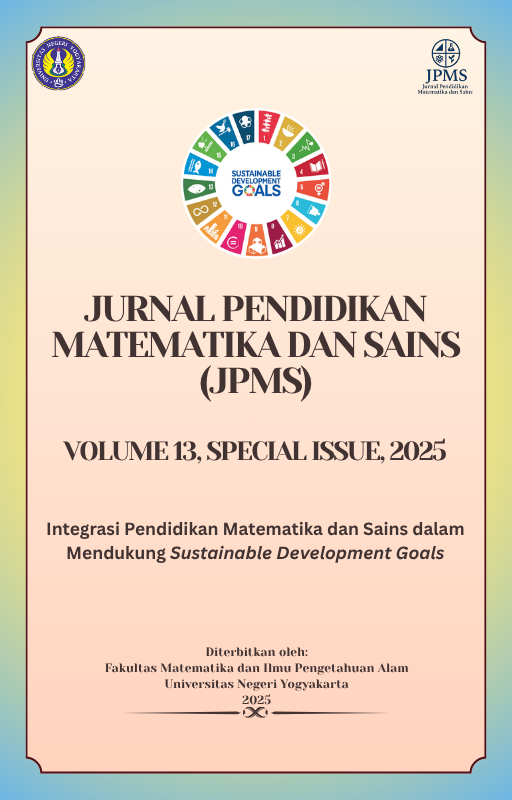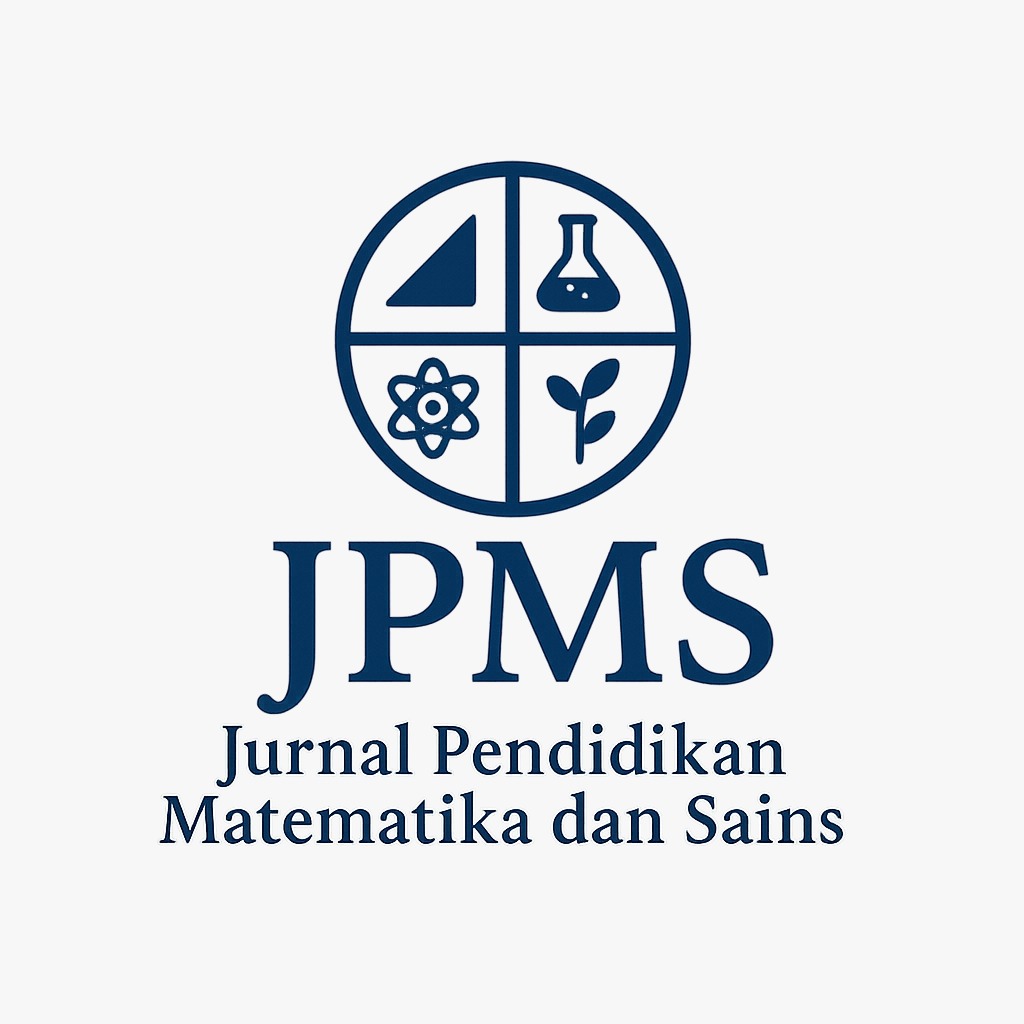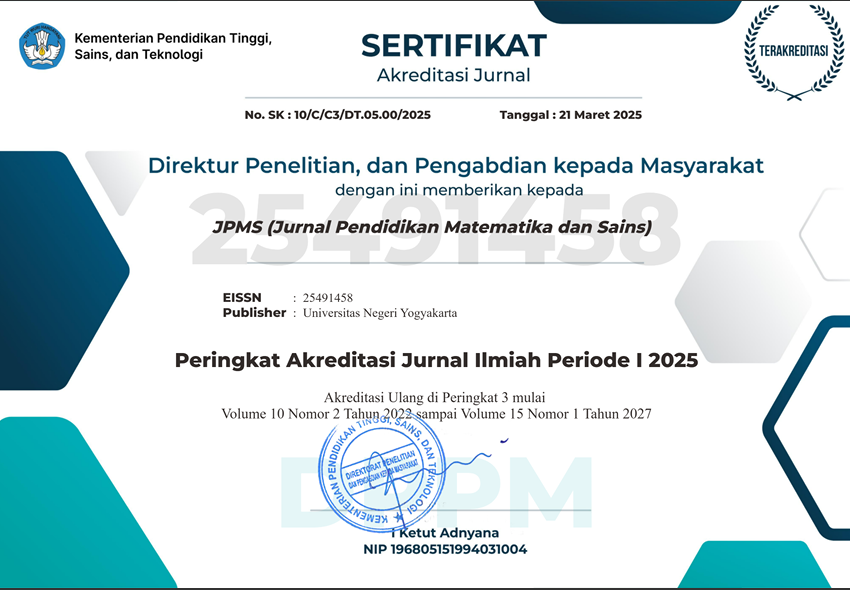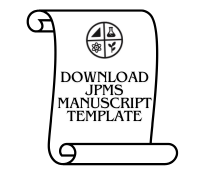LKPD dengan Learning Cycle 5E berorientasi NGSS terhadap Keterampilan Developing And Using Model dan Constructing Explanation
DOI:
https://doi.org/10.21831/jpms.v13iSpecial_issue.89301Keywords:
Constructing explanation, Developing and using model, Ikatan kimia, Learning cycle 5E, NGSSAbstract
Penelitian ini bertujuan untuk mengembangkan LKPD kimia dengan model learning cycle 5E berorientasi NGSS pada materi ikatan kimia terhadap keterampilan developing and using model dan keterampilan constructing explanation dan menguji pengaruhnya terhadap peserta didik. Uji coba produk dilakukan kepada peserta didik fase F kelas peminatan kimia di salah satu SMA Negeri di Gunungkidul. Subjek uji coba terdiri dari kelompok eksperimen dan kelompok kontrol dengan teknik pengambilan sampel yang digunakan adalah random sampling dan metode quasi experiment dengan desain posttest only control-group dan di uji dengan melakukan uji kelayakan, uji kepraktisan dan uji hipotesis. Uji hipotesis dilakukan dengan uji manova dan diperoleh nilai signifikansi sebesar 0,000 lebih kecil dari 0,05. Hal ini menunjukkan bahwa terdapat perbedaan antara keterampilan developing and using model dan constructing explanation peserta didik secara simultan pada kelompok eksperimen dan kelompok kontrol yang didukung oleh besaran nilai partial eta squared yang diperoleh sebesar 0,420.
References
Arini, S., Haryono, H., & Saputro, S. (2017). Upaya peningkatan kemampuan berpikir kritis dan prestasi belajar peserta didik dengan menggunakan model pembelajaran learning cycle 5e pada materi pokok hidrolisis garam kelas XI MIA 1 SMA negeri 1 Banyudono semester genap tahun pelajaran 2015/2016. Jurnal Pendidikan Kimia, 6(2), 161-170.
Atkinson, M. B., Krishnan, S., McNeil, L. A., Luft, J. A., & Pienta, N. J. (2020). Constructing explanations in an active learning preparatory chemistry course. Journal of Chemical Education, 97(3), 626-634. https://doi.org/10.1021/acs.jchemed.9b00901
Cooper, M. M., & Stowe, R. L. (2018). Chemistry education research—From personal empiricism to evidence, theory, and informed practice. Chemical reviews, 118(12), 6053-6087. https://doi.org/10.1021/acs.chemrev.8b00020
Erduran, S., & Jiménez-Aleixandre, M. P. (2007). Argumentation in science education: Perspectives from classroom-based research. Springer Science & Business Media.
Fahmi & Irhasyuarna, Y. (2017). The misconceptions of senior high school students in banjarmasin on chemical bonding. Journal of Education and Practice, 8(17):32–39
Gilbert, J. K., & Justi, R. (2016). The contribution of visualisation to modelling-based teaching. In Modelling-based teaching in science education (pp. 121-148). Cham: Springer International Publishing. https://doi.org/10.1007/978-3-319-29039-3_7
Grooms, J., Fleming, K., Berkowitz, A. R., & Caplan, B. (2021). Exploring modeling as a context to support content integration for chemistry and earth science. Journal of Chemical Education, 98(7), 2167-2175. https://doi.org/10.1021/acs.jchemed.1c00319
Hidayat, J., Firman, H., Sunarya, Y., & Redjeki, S. (2019, April). The profile of high school student’s mental model on chemical bonding concept. In 1st International Seminar STEMEIF (Science, Technology, Engineering and Mathematics Learning International Forum) (pp. 432-442).
Ihwanudin, M., Astuti, B., & Yulianto, A. (2018). Bahan ajar IPA terpadu tipe integrated berbasis komplementasi ayat-ayat Al-Quran. UPEJ Unnes Physics Education Journal, 7(3), 36-42.
Indayatmi (2017). Peningkatan Hasil Belajar Analisis Proksimat Melalui Model Research pada Peserta Didik Kelas XIII Kimia Analisis SMK. Jurnal Pendidikan Matematika Dan Sains, 5(2), 135–141. https://doi.org/10.21831/jpms.v5i2.15231
Kararo, A. T., Colvin, R. A., Cooper, M. M., & Underwood, S. M. (2019). Predictions and constructing explanations: an investigation into introductory chemistry students’ understanding of structure–property relationships. Chemistry Education Research and Practice, 20(1), 316-328. https://doi.org/10.1039/C8RP00195B
Ke, L., & Schwarz, C (2021). Supporting students’ meaningful engagement in scientiic modeling through epistemological messages: A case study of contrasting teaching approaches. Journal of Research in Science Teaching, 58(3), 335–365. https://doi.org/10.1002/tea.21662
Ke, L., Sadler, T. D., Zangori, L., & Friedrichsen, P. (2020). Students’ perceptions of engagement in socioscientiic issue-based learning and their appropriation of epistemic tools for systems thinking. International Journal of Science Education, 42(8), 1339–1361. https://doi.org/10.1080/09500693.2020.1759843
Kuncahyono, K., Suwandayani, B. I., & Muzakki, A. (2020). Aplikasi E-Test “That Quiz” sebagai Digitalisasi Keterampilan Pembelajaran Abad 21 di Sekolah Indonesia Bangkok. Lectura: Jurnal Pendidikan, 11(2), 153-166. https://doi.org/10.31849/lectura.v11i2.4687
Laliyo, L. A. R., Utina, R., Husain, R., Umar, M. K., Katili, M. R., & Panigoro, C. (2023). Evaluating students’ ability in constructing scientific explanations on chemical phenomena. Eurasia Journal of Mathematics, Science and Technology Education, 19(9). https://doi.org/10.29333/ejmste/13524
Lazenby, K., Rupp, C. A., Brandriet, A., Mauger-Sonnek, K., & Becker, N. M. (2019). Undergraduate chemistry students’ conceptualization of models in general chemistry. Journal of Chemical Education, 96(3), 455-468. https://doi.org/10.1021/acs.jchemed.8b00813
Mardhiyah, R. H., Aldriani, S. N. F., Chitta, F., & Zulfikar, M. R. (2021). Pentingnya keterampilan belajar di abad 21 sebagai tuntutan dalam pengembangan sumber daya manusia. Lectura: Jurnal Pendidikan, 12(1), 29-40. https://doi.org/10.31849/lectura.v12i1.5813
Mulyani, D., Ghufron, S., & Kasiyun, S. (2020). Peningkatan karakter gotong royong di sekolah dasar. Lectura: Jurnal Pendidikan, 11(2), 225-238. ISSN 2086-4876
NGSS Lead States. (2013). Next Generation Science Standards: For states, by states. The National Academies Press.
Nugraheni, N. C., Paidi, D., & Triatmanto, T. (2017). Kemampuan literasi sains kelas x SMA negeri mata pelajaran biologi berdasarkan topografi wilayah gunungkidul. Jurnal Prodi Pendidikan Biologi, 6(5), 261-272.
Osborne, J. F., & Patterson, A. (2011). Scientific argument and explanation: A necessary distinction?. Science Education, 95(4), 627-638. https://doi.org/10.1002/sce.20438
Pitaloka, N., Suyanta, S., & Huda, K. (2021, August). Improving constructing explanations and designing solutions skills based on NGSS through project-based learning: A systematic review. In AECon 2020: Proceedings of The 6th Asia-Pacific Education And Science Conference, AECon 2020, 19-20 December 2020, Purwokerto, Indonesia (p. 334). European Alliance for Innovation.
Prasojo, P. (2016). Pengembangan perangkat pembelajaran IPA berbasis inkuiri terbimbing untuk meningkatkan KPS dan berpikir kritis. Jurnal Pendidikan Matematika Dan Sains, 4(2), 130–141. https://doi.org/10.21831/jpms.v4i2.12944
Pratama, F. I., Rohaeti, E., & Laksono, E. W. (2025). Building Sustainable Education with the Literacy and Research-oriented Cooperative Problem-based Learning: A Bridge in the Activeness of Chemistry Education Students. Jurnal Pendidikan Matematika Dan Sains, 13(Special_issue), 61–68. https://doi.org/10.21831/jpms.v13iSpecial_issue.88392
Riefani, M. K. (2019). Validitas dan kepraktisan panduan lapangan “keragaman burung” dikawasan pantai desa sungai bakau. Jurnal Vidya Karya, 34(2), 194-204.
Safitri, A. F., Widarti, H. R., & Sukarianingsih, D. (2018). Identifikasi pemahaman konsep ikatan kimia. Jurnal Pembelajaran Kimia, 3(1), 41-50.
Sarip, M., Amintarti, S., & Utami, N. H. (2022). Validitas Dan Keterbacaan Media AjarE-Booklet Untuk Peserta didik SMA/MA Materi Keanekaragaman Hayati. JUPEIS: Jurnal Pendidikan dan Ilmu Sosial, 1(1), 43-59. https://doi.org/10.57218/jupeis.Vol1.Iss1.30
Shofiah, S., Lukito, A., & Siswono, T. Y. E. (2018). Pembelajaran Learning cycle 5e berbasis pengajuan masalah untuk meningkatkan hasil belajar peserta didik kelas X pada topik trigonometri. Kreano, Jurnal Matematika Kreatif-Inovatif, 9(1), 54-62.
Shoimin, A. (2016). Model Pembelajaran Kreatif. Ar-Ruzz Media
Simorangkir, A., & Raidil, M. (2025). High School Chemistry Learning: The Correlation Between Students’ Critical Thinking and Self-Efficacy. Jurnal Pendidikan Matematika Dan Sains, 13(Special_issue), 143–153. https://doi.org/10.21831/jpms.v13iSpecial_issue.88280
Thiagarajan, S., Semmel, D.S. & Semmel, M.I. (1974). Instructional Development for Training Teachers of Exceptional Children. Minneapolis, Minnesota: Leadirship Training Institute/Special Education, University of Minnesota
Yuliati, Y. (2015). Penerapan Model Learning Cycle 5e Untuk Meningkatkan Pembelajaran IPA. Jurnal Cakrawala Pendas, 1(1).
Downloads
Published
How to Cite
Issue
Section
Citation Check
License

This work is licensed under a Creative Commons Attribution-ShareAlike 4.0 International License.
Jurnal Pendidikan Matematika dan Sains allows readers to read, download, copy, distribute, print, search, or link to its articles' full texts and allows readers to use them for any other lawful purpose. The journal allows the author(s) to hold the copyright without restrictions. Finally, the journal allows the author(s) to retain publishing rights without restrictions
- Authors are allowed to archive their submitted article in an open access repository
- Authors are allowed to archive the final published article in an open access repository with an acknowledgment of its initial publication in this journal

This work is licensed under a Creative Commons Attribution-ShareAlike 4.0 Generic License.





